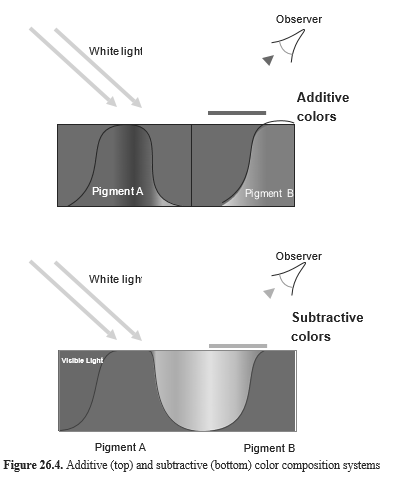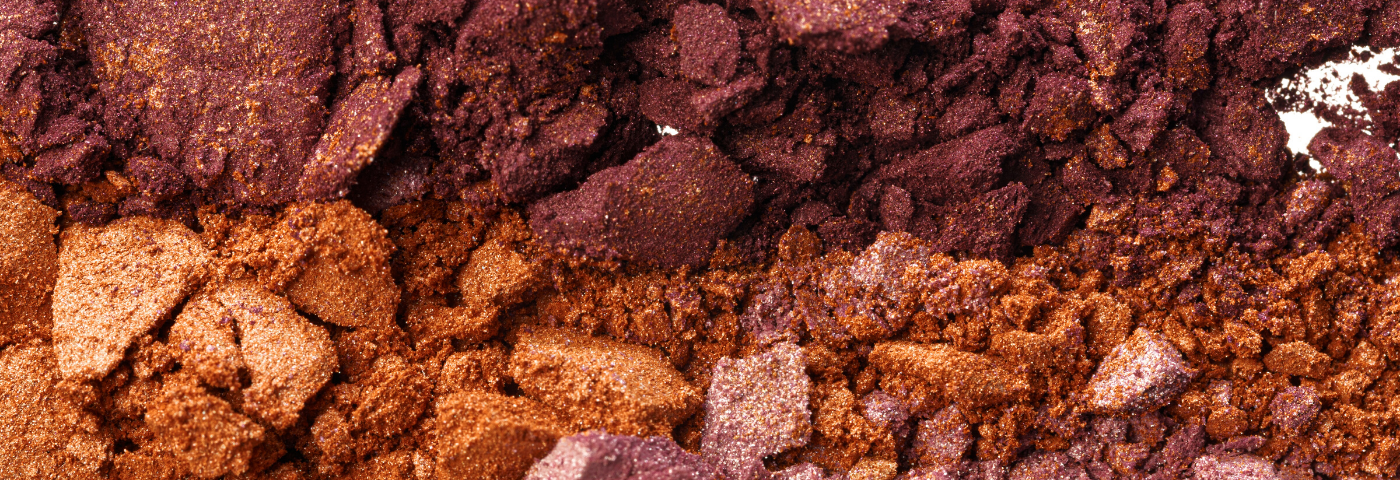Abstracted Section from Harry’s Cosmeticology, 9th Ed.
By Charles Warren
a. Pigments
Pigments impart color to the final formulation. They can be of two types: absorption pigments of interference pigments. Absorption pigments give color by absorbing part of the visible light spectrum. Their observed color results from reflection of the nonabsorbed light spectrum. Combining absorption pigments needs to consider the reflected light colors in order to avoid overlap of reflected light wavelengths and absorbed wavelengths. This is termed “subtraction color composition.” It is illus- trated by a trichromatic schematic showing that blue is the result of light absorption in the yellow or that red is the resulting color of light absorption at red wavelengths. Combining red and blue absorption pigments will yield a green shade instead of magenta. A good example of this color composition system is the CMY (cyan/ma- genta/yellow) system widespread in the printing industry. In a subtractive system, one starts from a neutral white light spectrum and each pigment removes a specific wavelength region from the white spectrum, leaving its remaining colors [4].

Figure 26.3. RGB and CMY trichromic color composition systems.
On the contrary, additive colors are obtained when pigments are the actual source of the color shade. Interference pigments act by selective reflection of a wavelength from the visible spectrum, and as such, pigments act similar to a light source. In this system, using a red and blue light sources will give a magenta light. In the additive composition system, one starts here with an empty light spectrum (dark). Each interference pigment adds a source of light to this dark background, which color relates to the reflective interference wavelength.
An illustration of the differences is given in Figure 26.4.

Fillers
The purpose of fillers is to opacify formulations to adjust the degree of transparency from a high-coverage foundation to a sheer foundation without affecting the color shade of a formulation. Fillers can lighten a formulation (higher concentrations above 5%) and they can induce a thickening of formulations. The most common fillers are titanium dioxides (white), talc (used less now), and silica particles. The particle size of fillers also influences the optical appearance of the product on skin.
Finer particles will give a softer appearance than larger particles. Finally, silicon dioxide particles are sometimes used to bring a slight light-scattering effect in foundations applied to skin, resulting in a soft-focus effect. They are often termed “light diffusion particles” and are generally coated for secondary purposes such as more hydrophilic/hydrophobic characteristics. The coating can also affect the opti- cal refractive index and enhance the light-diffusion effect. In addition, the coating generally prevents any sensitization risks when applied to sensitive skin.
Surfactants
These ingredients are often dependent on the type and concentrations of pigments as well as fillers. Their role is to disperse and maintain a homogenous dispersion in the liquid form. Common surfactants include stearates, dimethicones, oleates, and polyoxyethylene ethers (nonionic).
Thickeners
Thickeners serve to bring more texture to the formulation while also reducing the risk of pigment sedimentation inside a bottle. They are used in low amounts when needed, since the pigments and fillers will bring a formulation quite high in viscosity.
Film formers
Oils and silicones can be used to enhance spreadability on skin. Dimethicones are typical for spreadability while giving a dryer skin feel post-application. These compounds will also help skin adhesion of the formulation during its first minute following application. A good compromise needs to be reached in terms of time of setting of the foundation on the skin and time allowed for a consumer to evenly spread a formulation over the desired area.
Polymers
Polymers are widely used in foundations for multiple reasons. They will enhance film adhesion on skin (e.g., acrylate/C12–C22 alkylmethacrylate copolymer). Poly- mers also bring stability to the foundation film by maintaining pigments evenly dispersed while providing a degree of porosity and breathability (e.g., triacontanyl PVP). As mentioned before, film breathability is very important for skin to avoid
occlusion effects. Several polymers are often combined to ensure adhesion on skin and good retention of pigments over time of wear. This last benefit is responsible for wear resistance of a foundation to avoid any rub-off or staining of consumer clothes during the daily wear time of a foundation. Lastly, polymers can also bring a mattifying effect via sebum absorption/trapping and thus prevent the development of skin shine and oily appearance.
Additional ingredients
In addition to water, pH adjusters, preservatives, and antioxidants fall in this category to address the stability of the final formulation and its good compatibility with skin. Alcohols can also be used to give a slightly faster drytime.
In case you missed it, check out our introduction to formulation and approaches for foundations and lipsticks.


When I Make a foundation cream in lab every thing is ok,but after producing in reactor, color changes from yellow to red and yellow color separates in centrifuge. I don’t know why